Line up and watch the floats go by at Ann’s Musings on Geology and Other Things. You don’t want to miss it! Mardis Gras and geology – what could be better?
Author: Dana Hunter
Status Report
Ha, yes, still, um, y’know, busy. I’d like to write up something very profound and meaningful, but I’ve only got a tiny window of time here, and so here’s what I’ve got for you: an explanation.
The magma chamber’s filled. The volcano’s clearing its throat, a few phreatic eruptions here and there, harmonic tremors swarming, and let’s just say that it might be time to establish an exclusion zone. In other words, I’ve got ideas bubbling up. Which is why I haven’t even read Pharyngula in days, when I usually read it regularly every night.
A person standing outside looking in to my life just now would be a bit stymied. All they’d see is a woman watching Doctor Who obsessively (finished Series Three, for those who are interested). In between episodes, they’d witness me bouncing around the house talking to the air, breaking out in grins and gasps at seemingly random moments and diving for the nearest implement with which to move words from brain to page. Or scrap of paper. Or whatever’s handy. The cat had better be glad she’s not bald, or she might’ve ended up as a notepad.
Sleep, when it’s possible, happens in a scant handful of hours here or there.
Things that normally would hold my attention go unnoticed. Haven’t read more than a page or two in a book, just a few blog posts here or there, and I’ve even turned off Twitter a few times. That’s extreme, that is. That just doesn’t happen. It’s about this time that a psychiatrist who isn’t in the know might reach for ye olde prescription pad and suggest I get down to the pharmacy straightaway.
Writers, on the other hand, just would look upon all of this, shrug with a little knowing grin, and say, “Inspired, eh?”
Yep.
Every writer works differently. We’ve all got various ways of kicking the Muse off her chaise lounge, snatching the grapes away and screaming, “Get a move on, you lazy git!” For me, it usually comes after something of a dry spell, when I’ve spent a lot of time doing the busy work – researching bits, building bits of this world or that, or maybe just seeming to ignore everything entirely whilst I read blogs and books and – well, that’s very nearly the whole of what I do in winter when I’m not actively writing, actually. Blogs and books. Email a few friends (hullo, you! Yes, I’ll get there, I promise, I’ll email you again before summer!). For a time, it may seem like I’ll never write another word of fiction ever again in my entire life. I start to question What It’s All About, Really and Am I Actually a Writer? That sort of thing. Inspiration does not come standard. Sometimes, it doesn’t really come at all. I used to freak out over that. Used to panic and despair. These days, I just shrug, say “Huh,” and take the opportunity to do other things. Always feeling vaguely guilty, like I should be over by that chaise lounge giving the Muse a good kick in the arse, like I should be forcing it, but when I try, the Muse just gives me a Look that says my foot-on-arse action isn’t impressing her a bit, and the forced words are, well, forced. Obviously so. Horribly so. And something in me feels like it’s broken. So, when faced with those times when the magma chamber’s emptied and the volcano is dormant, these days, I just sit back and relax.
Because I know something will happen.
Might be a word, in the right place at the right time. Or a couple of completely unrelated events, banging up against each other in my mind and fusing like hydrogen atoms in the sun. Or it could be a book. Maybe a movie that unlocks doors, throwing them wide open.
Or it could be a show.
And then what happens is that I go over and over and over it. It’s not like it’s a choice, not really. It demands my attention, grabs me by the lapels and pulls my face down to its face and screams from less than an inch away, “Listen to me!” And all I can do is watch or read or ruminate over it continually. Look at it from all angles. Some bits will step front and center as the essential ones, and I study them. There’s a reason why they got my attention. There’s a reason why they’ve demanded I put my whole life on hold for them. What is it?
That’s when the harmonic tremors start, and the magma chamber fills, and the volcano prepares to vent the heat of creation all over what had been, until then, a rather nice, quiet, and possibly even scenic life.
Other things get neglected while that goes on. Food, sleep, friends, blogs, books, and quite often the cat, because it only goes on for so long before it’s done, the volcano goes dormant again, and then it’s back to the usual activities until the magma chamber fills again.
Which is all a long way of saying, I’m a little distracted right now, so I might be a bit neglectful. Sorry ’bout that.
Oregon Geology Parte the Ninth: Taking the Plunge
We’ve certainly had quite the adventure, haven’t we? Been through Astoria, Ecola State Park, Hug Point north and south; we’ve enjoyed the world’s shortest river, Cape Kiwanda, and Cape Meares, and at last have made it here to the Columbia River Gorge. Now, and try not to be too shocked here, we’re going to go see ourselves more basalt.
Well, that and some waterfalls.
Nothing too spectacular, mind. I mean, we’re only going to see the second highest waterfall in the United States. It just plunges 620 feet over sheer cliffs of Columbia River Basalts. It’s just sort of, y’know, kinda like ZOMG WTF holy haleakala Batman!
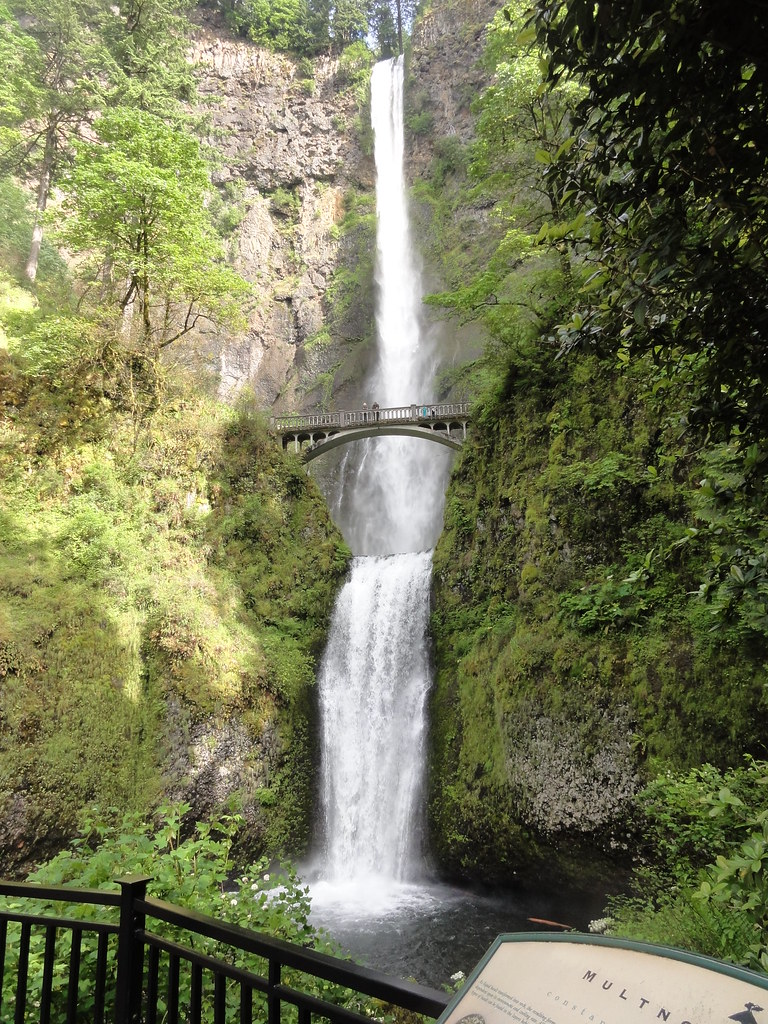 |
| Multnomah Falls |
Okay. Yeah. That’s pretty bloody spectacular, that is. Let’s just stand here silently for a moment and stare.
Stared enough? Okay. Let’s talk geology, then.
Over the course of 400,000 years, flow after flow of Columbia River Basalts laminated the landscape in thick black basalt. You can see quite a few of them in the cliff Multnomah Falls cascades down. Up by the lip there, you can see a wee colonnade, followed by a black band of pillow lava. I want to pause at pillow lava for a moment, because that tells us something fascinating about the history of this place. A casual glance at this enormous, solid cliff gives the impression that it was all basalt all the time back then, but the pillows say, “No, wait – it wasn’t always flow after flow of blazing hot lava round here. Look, there was even a pond, or maybe a little lake, right here. Well, until the next wave of molten rock came through, anyway.”
That picturesque pond of water formed on top of a rather thicker previous flow, which you can see as an entabulature and colonnade. Those three flows pretty much take up the whole of this photo.
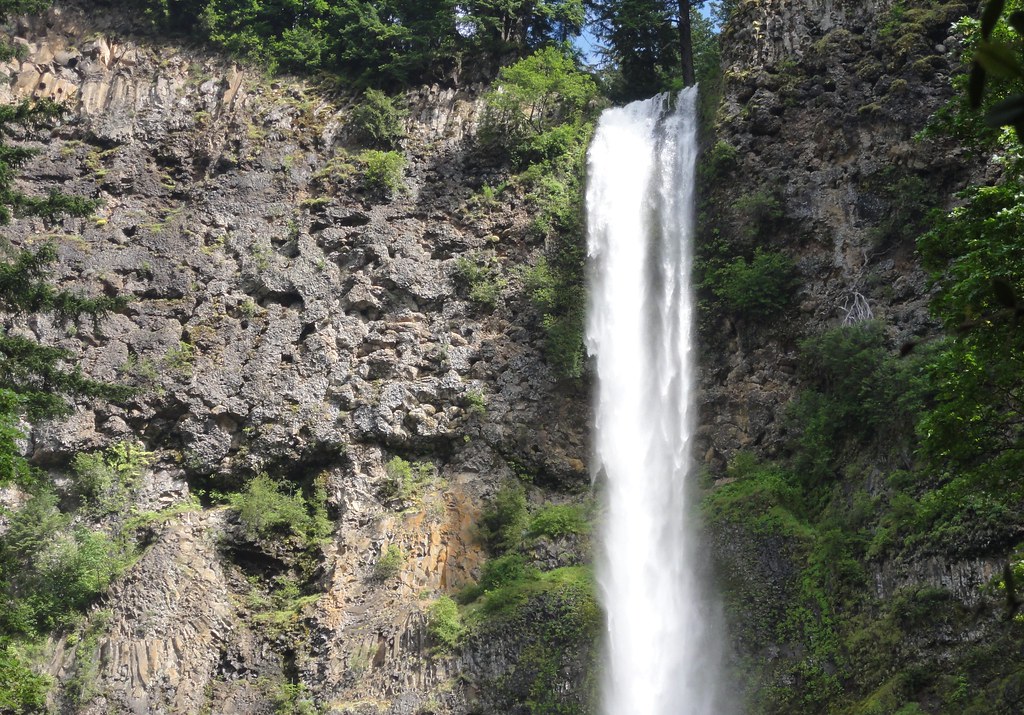 |
| Top o’ Multnomah |
That’s a damned lot of basalt. But wait! There’s more!
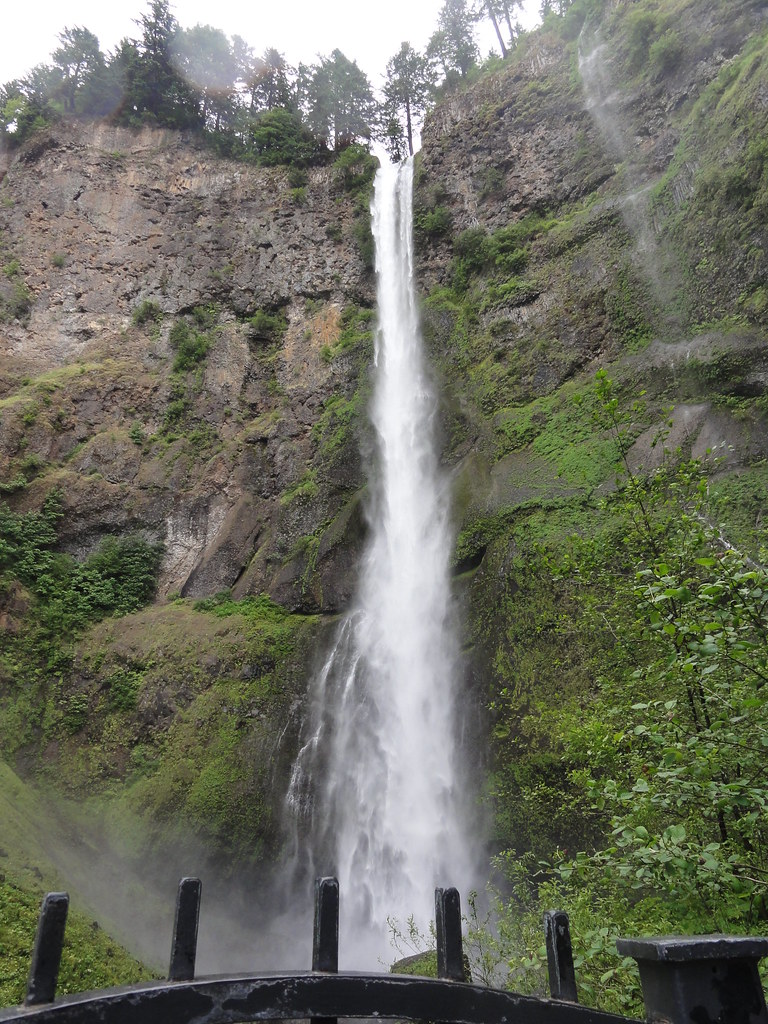 |
| Multnomah Falls – Upper Falls |
A little over halfway down the cliff, you’ll see the falls hit a ledge and fan out. It’s striking the fourth flow, and hiding the fifth: two entabulatures and a small colonnade. If there wasn’t so much hydrology and biology in the way, you’d be able to see more of the geology, but that other stuff’s pretty so we won’t complain. Much.
Let’s have a look into the plunge pool, shall we?
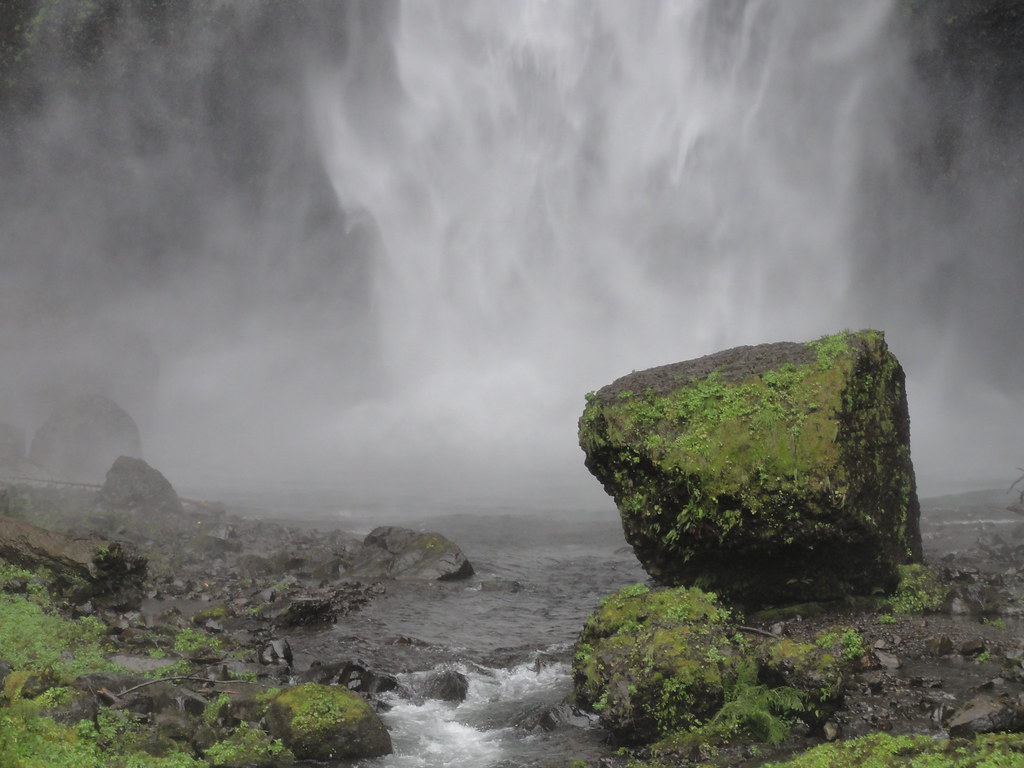 |
| Multnomah Falls Plunge Pool |
Here lies the boundary between the fifth and sixth flows, but the more interesting feature in this photo is the enormous boulder. It’s hard to tell in these photos – all the flows look pretty welded and solid. But in between flows, erosion happened, and soil horizons formed, and those are more easily attacked by falling water. It gets cold in the winter, too, and frost works its wedge in. Eventually, big chunks of cliff fall down and go boom. Some of them are gargantuan – up to and including the size of a bus.
While you’re wandering the trail at Multnomah, don’t forget to have fun away from the falls. There’s some delicious geology, including a nice, cozy cave.
 |
| The Cave and I |
Here’s another view, sans moi:
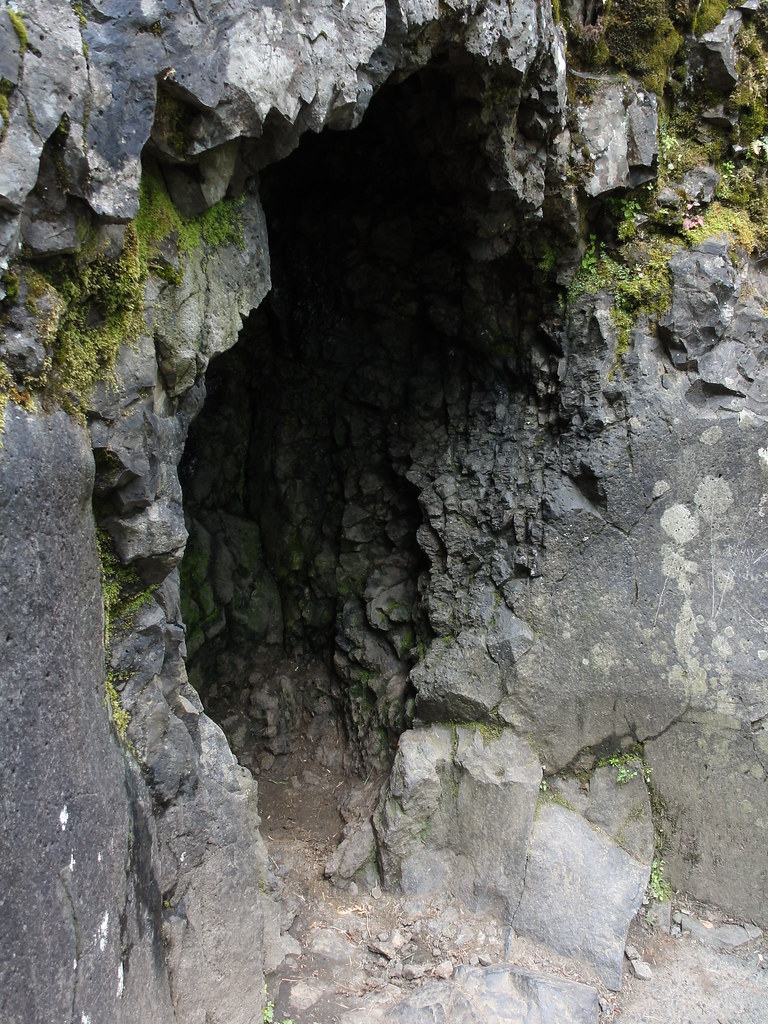 |
| Cave |
You can see it’s in the entabulature, and it is awesome. Not sure how it was formed, though, so you’re on your own there.
And a nice, close view of basalt here:
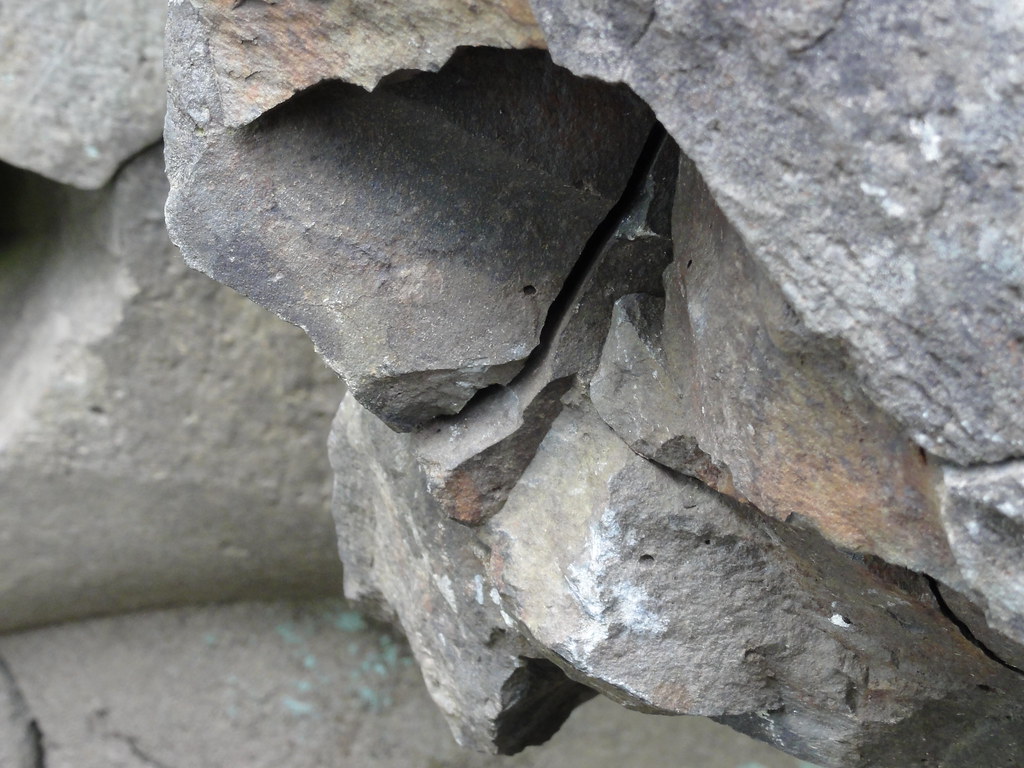 |
| Basalt |
Not many vesicles, as you can see. It’s pretty solid stuff – aside from all the cracks and fractures. Not quite so solid as it looks, that. But absolutely lovely.
Multnomah Falls has carved itself a respectable ampitheatre over the years. The view from beside it is utterly spectacular:
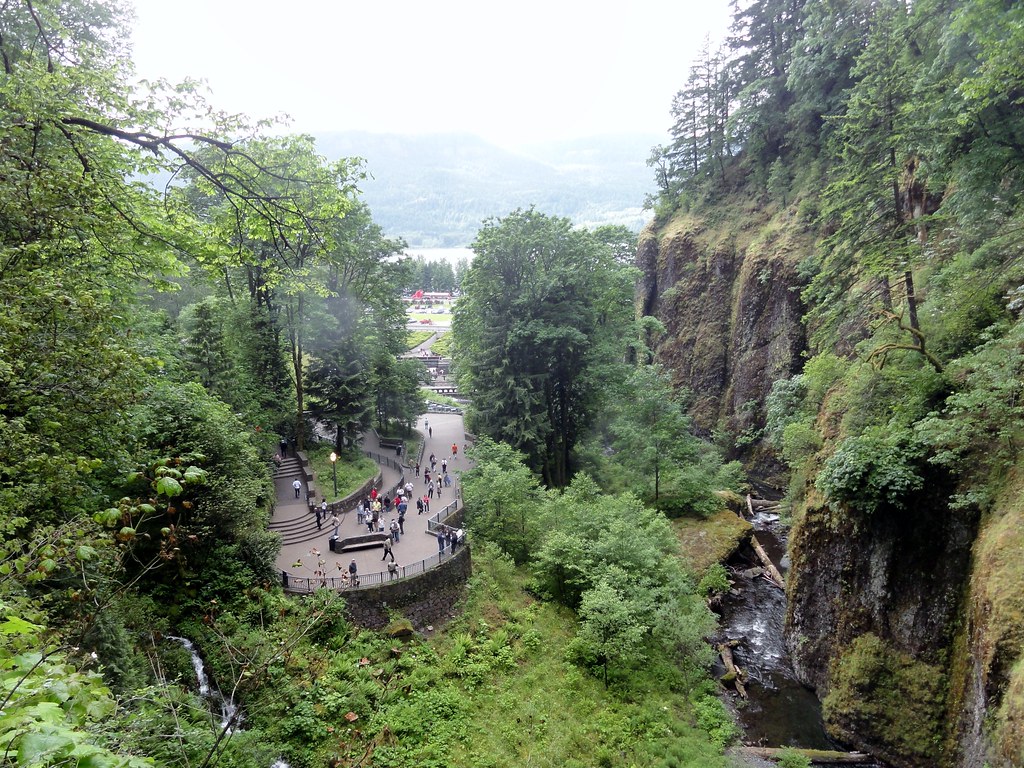 |
| Ampitheatre |
Isn’t that outstanding?
So, you’ve seen the second tallest waterfall in the United States and gotten really intimate with the Columbia River Basalts. You may think nothing else can live up to that and your adventures are over, but what you need to do is drive down Samuel C. Lancaster’s delightful historic highway. The scenery is spectacular and the geology even more so. Check this out:
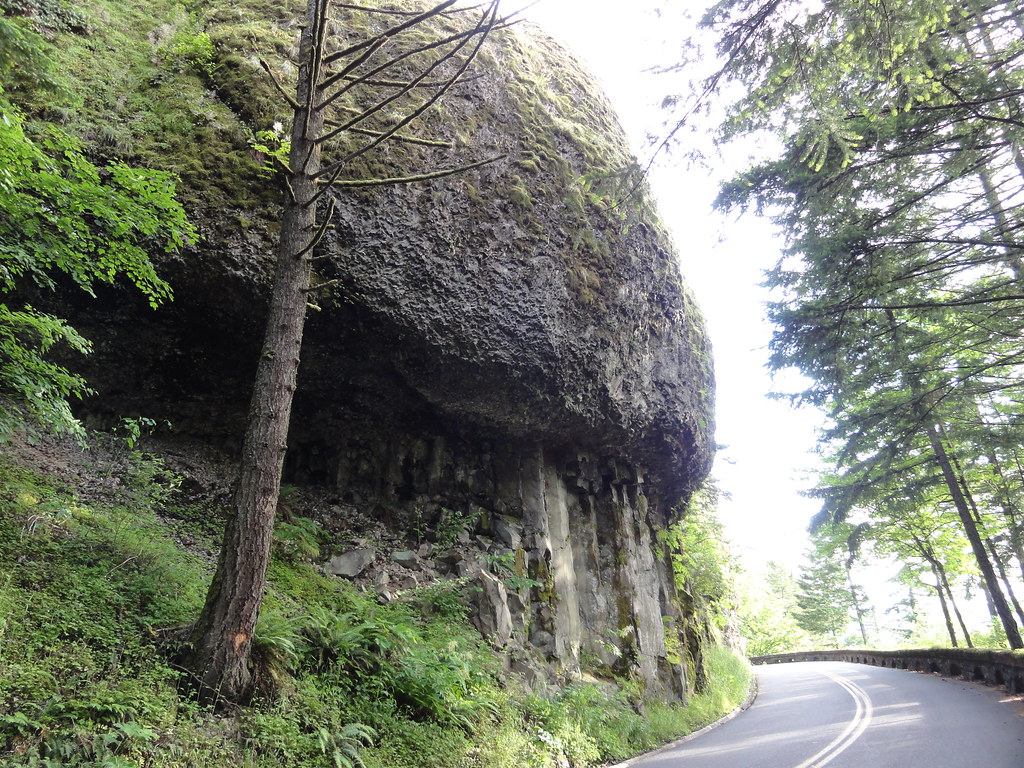 |
| Basalt Mushroom! |
Is that not one of the greatest entabulature-and-colonnades you’ve ever seen? Here’s a nice closeup:
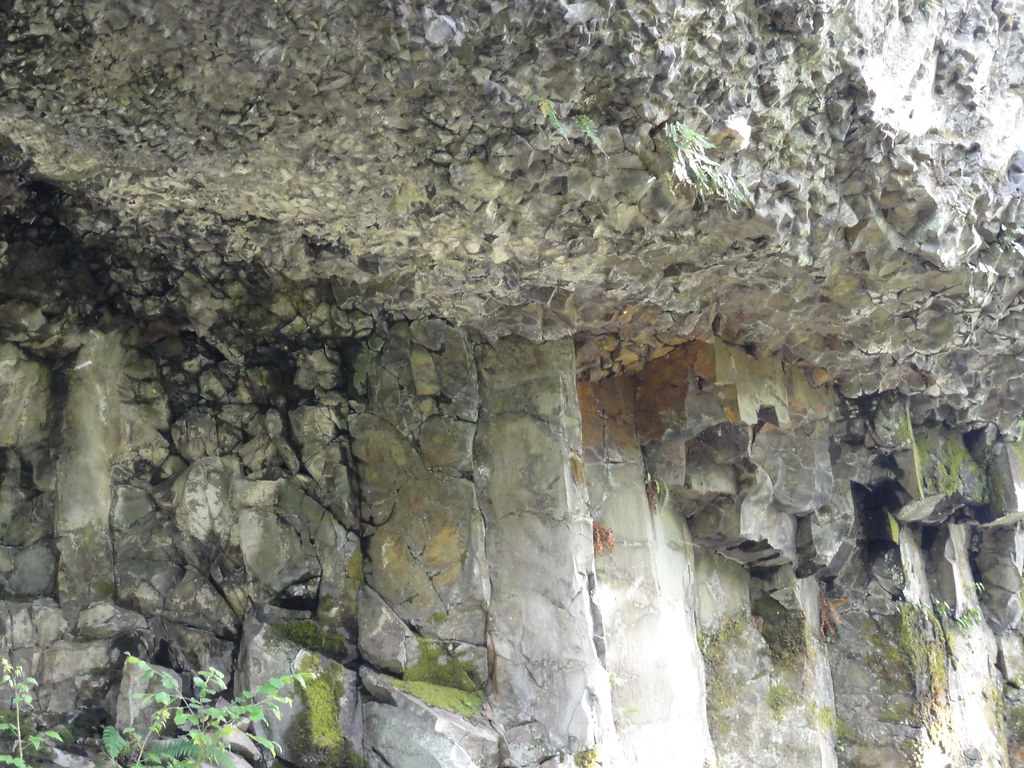 |
| Boundary Between Colonnade and Entabulature |
Drive on, stop at Latourell Falls, and you’ll find something even more interesting:
 |
| Ooo, Platy! |
I think – and mind you, I’m not sure, but I think – this is the lovely gray outcrop of Oligocene Skamania volcanics Ellen Morris Bishop mentioned in Hiking Oregon’s Geology. And if so, that means that these are far older than the Columbia River Basalts – at somewhere between 25 and 30 million years. They stood there while the flood basalts flowed around them, and still stand today. Beautiful!
Or I’m wrong and they’re just a fine example of platy basalt. Either way, I love them. So much, in fact, that I think they deserve another look:
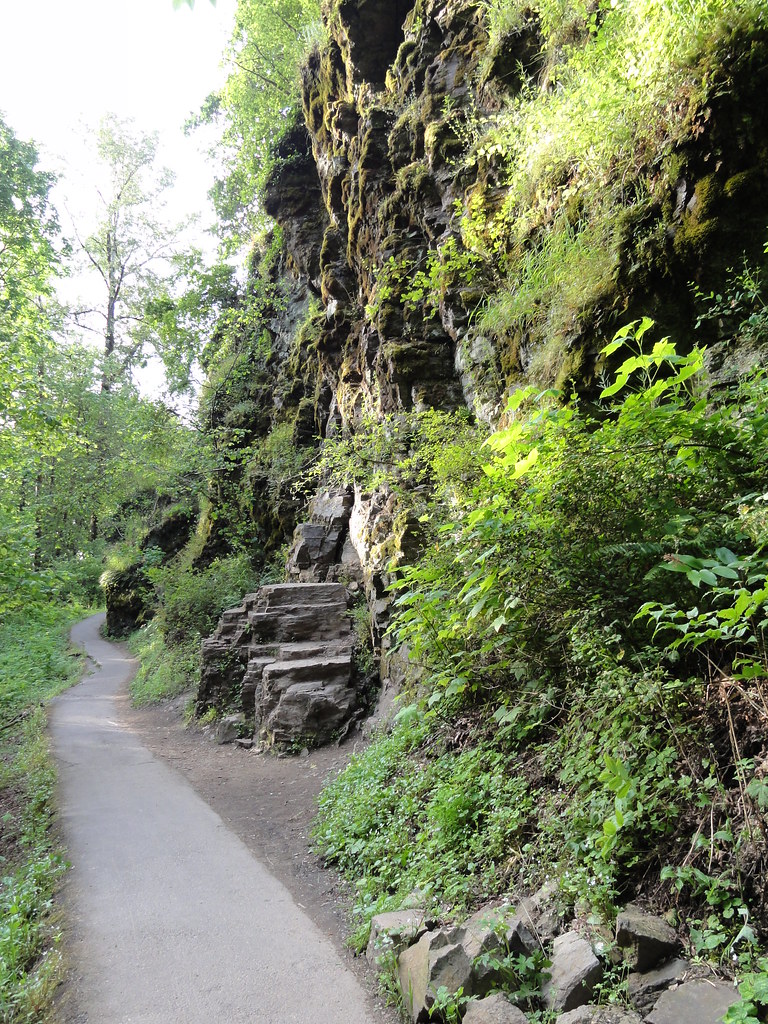 |
| Lovely Little Outcrop |
Things get even more interesting on down the trail. Latourell Falls takes a 250 foot dive over three separate flows of the Columbia River Basalts – our old friends the Grande Ronde (lowest and oldest), the Frenchman Springs, and the Priest Rapids. Check this out:
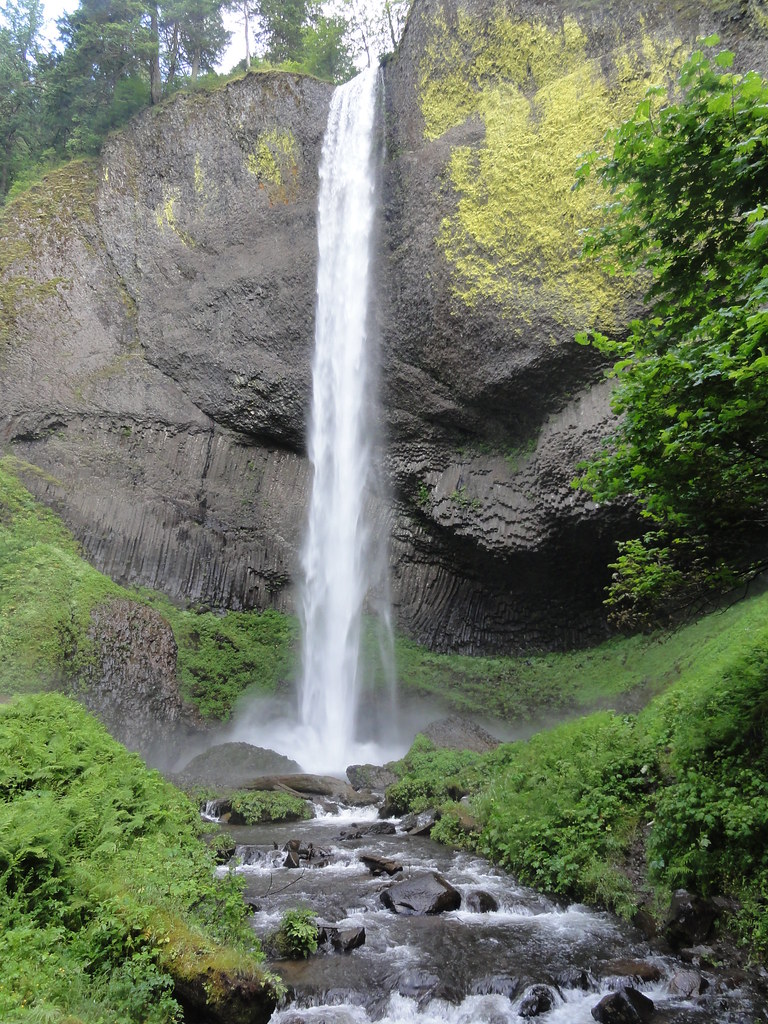 |
| Latourell Falls |
Look, just look, at the entabulature and colonnade on that thing!
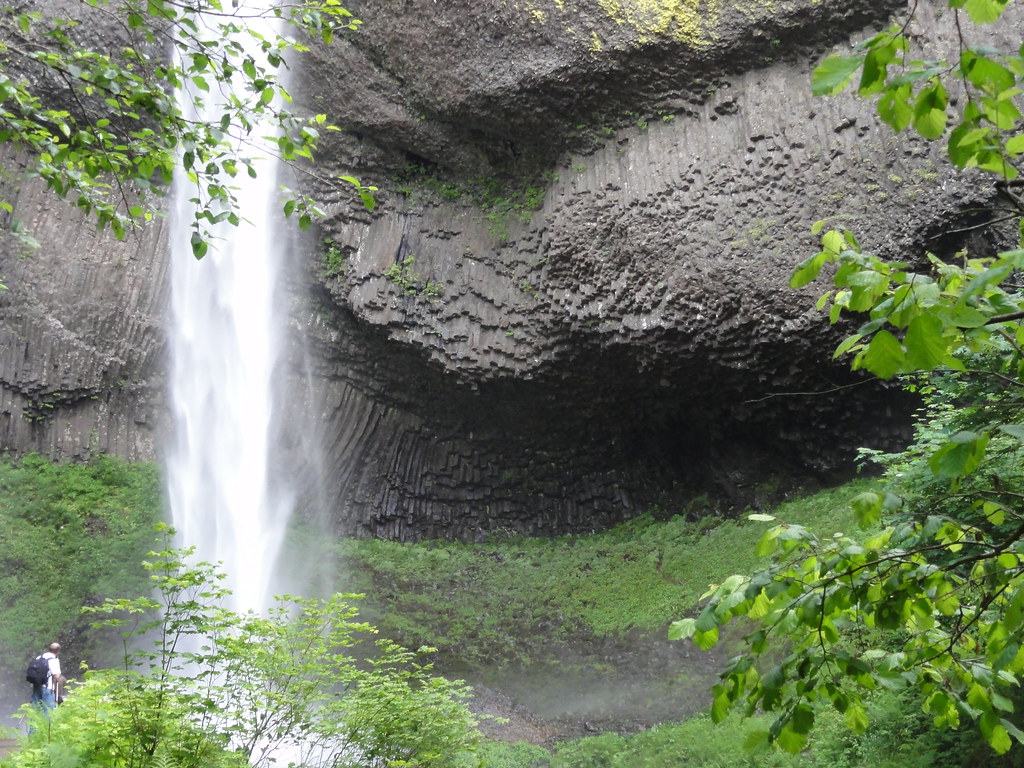 |
| Columns |
And what’s even better is that you can walk right along the side of Latourell Creek and enjoy everything up close, personal, and powerful. Standing on the edge of a plunge pool is teh awesome.
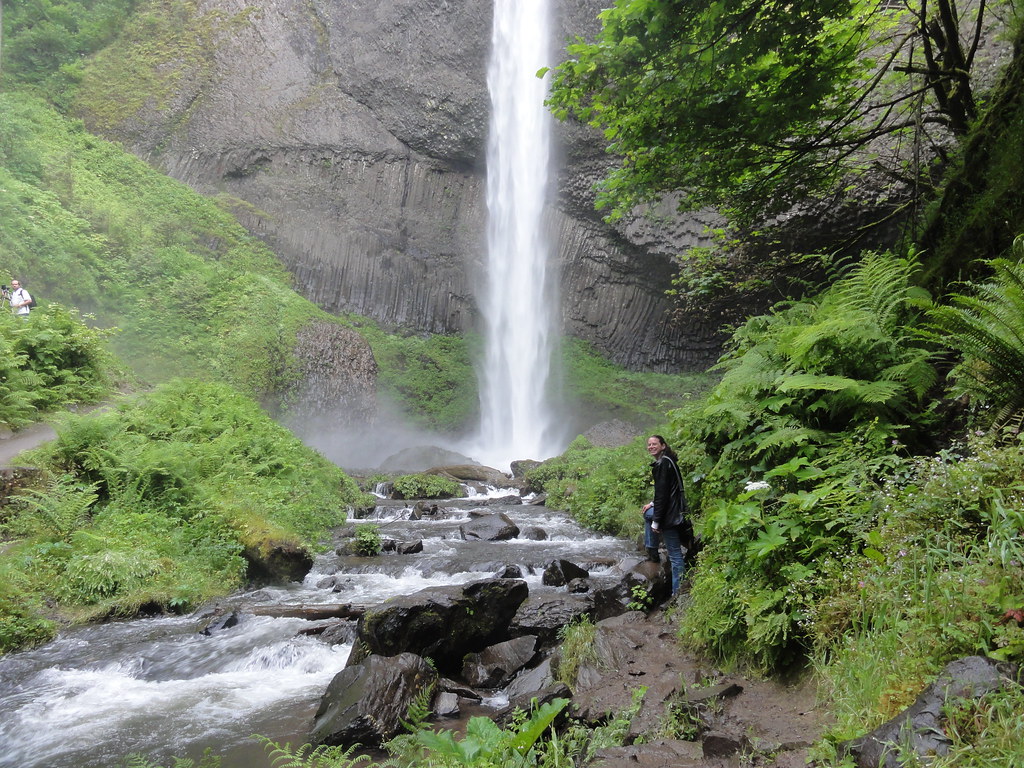 |
| Hooman for Scale |
It’s hard to imagine, looking at this, that it began as glowing fountains of molten rock spilling from vents over three hundred miles to the east, over hundreds of thousands of years, wave after wave, paving the earth in deep black basalt. Let a little erosion happen, a catastrophic flood or several dozen, bung in some plants and streams, and you have something that fair takes the breath away.
Isn’t geology wonderful?
Dana's Dojo: Mythical Writing Part I
Today in the Dojo: Why your writing could use a heaping helping of myth.
Clearly, mythology is no toy for children. Nor is it a matter of archaic, merely scholarly concern, of no moment to modern men of action. For its symbols (whether in the tangible form of images or in the abstract form of ideas) touch and release the deepest centers of motivation, moving literate and illiterate alike, moving mobs, moving civilizations.
-Joseph Campbell, Primitive Mythology
I’ve been doing a lot of thinking about myth and writing lately. I’m not talking about the myths of writing (of which there are a plethora), but the role of mythology in stories. Reading endless amounts of Joseph Campbell will do that for you.
This isn’t a new thing. Back in the day when I was young and callow and just starting to get a handle on what writing was, I noticed a definite pattern: my favorite books, the stories that stayed with me long after “The End”, were those based on myth. It didn’t matter whether or not I’d ever heard the myth before. It made no difference if I even recognized the mythical theme at the time. Anything with a solid base in myth had a richness and depth that resonates years later.
And that is why I spend months out of every year reading all of the books on mythology I can get my grubby hands on. To be an excellent writer, I must have myth.
In this three-part article, I’m going to attempt to give you the same insight and information I’ve had the great good fortune to acquire. Part One explores the general idea behind mythical writing, including some useful definitions and some unexpected reasons why myth and writing go together like yeast and wheat. Part Two will open up the world of myth, going beyond the Occident even into our own mythogenesis. Part Three will explore some useful mythic structures. And all three parts will include some spiffy resources you can go to for a crash course in mythology.
Are you excited? I’m excited. So let’s get started.
PART ONE: A SURVEY OF MYTH AND WRITING
First off, let’s debunk a possible myth before it gets started: writing mythically doesn’t mean you’re writing fantasy. I’m sure there are plenty of people out there who think that only fantasy writers use mythology in their writing. And it’s true that some of the greatest mythologically-based books have been fantasy books: J.R.R. Tolkien’s Lord of the Rings, Neil Gaiman’s American Gods, Robert Jordan’s Wheel of Time series, Robert Holdstock’s Mythago Wood tales, Patricia A. McKillip’s Riddle-Master trilogy…. I could go on all night. But the list of great books based on myth does not begin and end in the fantasy section of the book store. Check out this list:
Ulysses by James Joyce (Fiction & Literature)
Siddhartha by Herman Hesse (Fiction & Literature)
No Exit and Three Other Plays by Jean-Paul Sartre (Fiction & Literature or Drama/Theatre)
The Haunted Mesa by Louis L’Amour (Westerns)
Skinwalkers by Tony Hillerman (Mystery)
The Dancing Wu Li Masters by Gary Zukov (Science-Physics)
The Divine Comedy by Dante Alighieri (Classics)
Does it surprise you to see an author of popular Westerns and a book on physics in there? Then it’s really going to shock you to know that the great Christian author Dante Alighieri drew just as heavily on Islamic stories as he did Christian ones. Islam’s influence is all over The Divine Comedy.
So now that I’ve somewhat proven that mythology underlies some of the best writing of all times and all genres, creeping into places you’d never expect to find it, let me attempt to define what mythology is.
In this context, no matter what your beliefs may be, you must understand that Christianity, Islam, and every other religion qualifies as myth and will be discussed as such. This brings me to the second myth to debunk: Calling something a myth doesn’t mean it’s not important. On the contrary, mythology is extremely important to us. We use mythology to understand, to inspire, and sometimes to enlighten. We’re not talking the kind of myths the Mythbusters bust.
Let this become our definition: At core, myth is a story we tell to make sense of the world and people.
People need symbols, and they need stories. Mythology provides both. And since it’s been around for so long, we tend to recognize the symbols in those stories pretty easily, even if we can’t isolate them. In fact, Carl Jung and others believed that certain mythic symbols are part of our common heritage, found in the dreams of people who had never heard of the original myths that contained them. H.R. Ellis Davidson points out in Gods and Myths of Northern Europe that the symbols found in everything from fairy tales to epic myths “may be borrowed… by one religious system from another, but the reason why they are retained and develop such vigorous life in the new context seems to be due to the deep appeal which they possess to the human mind. They express something of the desires, urges, and fears common to men of every age…. Thus it is that when we meet them in a legend or in poetic imagery, we experience immediate recognition of their rightness and power.”
Now, that’s power.
A lot of comparative religion has explored the commonalities between widely disparate mythologies. Some use those commonalities to prove that their myths are”true” (meaning factual history, like a great flood that actually wiped out a good portion of humanity), but those who do are sadly mistaken. Those commonalities aren’t there because of some dimly-remembered event: they’re there because they reflect how the human brain functions. They provide a pattern that helps us understand things like birth, death, and life. They’re patterns that our minds find easy to recognize. Even those myths that are based in historical fact, like the siege of Troy, are just using an event to say something a lot more meaningful about what it means to be human than “yeah, there was this war, and a lot of interesting stuff happened.” Myth means that the war becomes more than an armed conflict, two people’s courtship is more than a story to tell the grandkids; indeed, myth can elevate any story one can tell from anecdote to philosophy of life.
That’s why myth is so vitally important to writing. The best writers understand that salting their tale with a myth or two makes all the difference. Following mythic structure can take an otherwise ordinary tale and turn it extraordinary. It might be as obvious as retelling the myth with all the original names in a new setting, or as subtle as setting a callow youth on a modern-day Odyssey through the streets of Dublin. It’s up to you just how much myth you use, and how identifiable it will be.
However you choose to use it, though, myth can give your stories more depth, resonance and meaning than you ever believed you could manage.
Before we close Part One, I’m going to gloss the major Occidental myths: Greek, Roman, and Christian. This is because the resources for those are vast, obvious, and probably well known to you. That doesn’t mean that you should avoid using them. By all means, if your story wants to follow the structure of Lucifer’s fall, or Prometheus’ theft from the gods, or Romulus and Remus founding Rome, go for it. Even the most well-treaded paths can reveal something fresh through new eyes. It doesn’t even have to be spectacular and original. After all, these stories have been around for thousands of years because people enjoy them. They’re easily recognized, which can be very useful for writing. It’s always nice when we don’t have to spend a hundred pages explaining something. If you use a myth commonly known, you have a lot less work to do on basic structure and a lot of freedom to play with other things. Just be careful not to let your archetypes become stereotypes.
So, I’ve (hopefully) won you over with my semi-coherent reasons why you should write with myth in mind, but you don’t know all that much about mythology. Not a problem. Outside of the obvious sources, here are a few general resources that will give you plenty of material to start out with:
PART ONE RESOURCES
The Joy of Sects by Peter Occhiogrosso. You know from the title that this book is going to be wonderfully tongue-in-cheek. It’s a lively survey of world religion, covering all the major ones both East and West in a fashion entertaining enough to keep you from waking up in your chair with a drool-sodden book over your face.
Mythology: An Illustrated Encyclopedia edited by Richard Cavendish. A gorgeous survey of world mythology written by experts in the field. It covers all of the well-known traditions and provides articles on many that you may not have known about at all. An excellent introduction to the subject.
Mythology by Edith Hamilton. This book mostly deals in Greek and Roman mythology, but it’s also got a bit on the major Norse myths. Edith knows her stuff, and she makes even the most well-known Greek
and Roman tales seem fresh and new.
Subterranean Homesick Blues, Here I Come!
I just got my package of books from Wayne Ranney. (Actually, I probably got them a week ago, but I’ve only just now checked the mail.) You know what this means, don’t you?
Pain, that’s what.
You see, Wayne’s a wonderful writer, and he’s got all of Arizona’s delicious geology to go play in, and these books will be filled with all of the places I used to ramble through for the first three decades of my life. I shall love them. But you can expect the occasional sentimental post arising from them, because they’ll remind me how much I miss ye olde home state (although not its government). We’ll be taking some rambles through Arizona’s spectacular landforms, guided by Wayne and a few others, in the months to come.
While you’re waiting for me to get round to it, you can go visit Wayne’s blog, where he has a spectacular post up on the Esplanade Platform:
Far away from the main tourist areas in Grand Canyon lies a huge wilderness of stone and space. It is silent beyond belief and seldom visited. Within this huge expanse lies the Esplanade Platform, a stunning landscape feature that is found only in the central and western portions of the canyon. The Esplanade forms a broad terrace positioned about a fourth of the way down in the canyon, where the Hermit Formation overlies the Esplanade Sandstone. The Esplanade thus creates a canyon within a canyon. Geologists have long been intrigued by the presence of the Esplanade Platform in Grand Canyon and many theories have been proposed to explain its origin. Did the Colorado River carve it during a period of erosional quiescence, as some say? Or did it form in response to the canyon’s variable stratigraphy? I explored these questions on a recent trip to the Esplanade. From February 10 to 16 I was privileged to backpack with two other friends here. This is our story.And it’s illustrated. Lavishly. So get thee to Wayne’s place and enjoy.
The Limits of Tolerance
Johann Hari asks a very good question: “Can we talk about Muslim homophobia now? (h/t)”
Here’s a few portents from the East End that we have chosen to ignore. In May 2008, a 15 year old Muslim girl tells her teacher she thinks she might be gay, and the Muslim teacher in a state-funded comprehensive tells her “there are no gays round here” and she will “burn in hell” if she ever acts on it. (I know because she emailed me, suicidal and begging for help). In September 2008, a young gay man called Oliver Hemsley, is walking home from the gay pub the George and Dragon when a gang of young Muslims stabs him eight times, in the back, in the lungs, and in his spinal column. In January 2010, when the thug who did it is convicted, a gang of thirty Muslims storms the George and Dragon in revenge and violently attacks everybody there. All through, it was normal to see young men handing out leaflets outside the Whitechapel Ideas Store saying gays are “evil.” Most people accept them politely.These are not isolated incidents.Johann brings up the point that because Muslims are so frequently targets of bigotry, harassment and violence themselves, there’s an understandable reluctance to speak out against their less-admirable acts. It’s easy to get yourself branded Islamophobic for pointing out that Islam isn’t necessarily a religion of peace, and that strict adherence to Islam leads to despicable acts. But, as Johann says,
It’s patronizing – and authentically racist – to treat Muslims as if they are children, or animals, who can only react to their oppression by jeering at or attacking people who have done them no harm, and who they object to because of a book written in the sixth century. Muslims are human beings who can choose not to this. The vast majority, of course, do not attack anyone. But they should go further. They should choose instead to see us as equal human beings, who live and love just like them, and do not deserve scorn and prejudice.
Giving people a pass to be bigoted, damaging jerks just because they’re a member of a despised minority doesn’t do any sector of society any good. It normalizes dangerous behavior. It doesn’t confront the intolerance before it gets wildly out of control. And it only feeds cycles of oppression. No one – not even atheists – are saying Muslims have to give up their religion. But we expect Christians and Jews and members of other faiths to respect gay folks, even if they do think gays are icky. It’s ridiculous to give homophobia a pass out of some misguided sense of fairness. It’s not fair. It’s not fair to Muslim people who are lesbians or gays or bisexuals or transgendered. It’s not fair to those Muslims who might discover that their religion can accommodate gays just fine. And it’s not fair to the wider community, LGBT and allies, who are sick to death of seeing people get harassed, hurt and killed because of the way they love.
There are limits to tolerance. We can tolerate people of other faiths. We can’t tolerate actual harm they do for the greater glory of God. Let’s do talk about Muslim homophobia, just as we talk about homophobia in all its many disgusting forms. Let’s not stay silent about issues that are so critically important.
Cantina Quote o' The Week: Democritus
A life without festivity is a long road without an end.
Yes, you know him mostly because, with his mentor Leucippus, he came up with the idea of the atom. But he was also known as the Laughing Philosopher (because he engaged in round mocking of human inanity), and as you can see from the quote above, he didn’t believe in being dour. He was a well-traveled man who was insatiably curious about the world, and became respected by his contemporaries because he understood the natural world well enough to predict some happenings in it. Some of his ideas on the origins of worlds and their eventual end are eerily prescient – we now know that bits of matter colliding is what forms planets, and that collisions between worlds can, indeed, destroy them. I expect if we could transport him to the present, he’d get a kick out of modern cosmology, which in these respects has largely proven him right. And he’d have plenty of human inanity to laugh at.
So, heed the wise words of Democritus and go have yourselves some fun.
Mother's Day
Just talked to my mom for something approaching four and a half hours. The relationship we have is complicated – bound to be, considering she’s bipolar with occasional psychotic breaks, and I’ve got one hell of a temper. And we’ve both occasionally put each other through hell. Neither one of us is a perfect person.
And you know what? We don’t have to be.
She gave me the kind of childhood most kids can only dream about. And even when she’s lost her mind, she’s always been there for me. I hope, after this conversation, that she understands that. I’ve never once had to wonder if my mother loved me. Wondered how she could love me a few times, mind, but never doubted she did. She’s been my anchor. If everyone else in the world stopped loving me, she still would. That can’t be minimized.
And I love her. Finally got a chance to really tell her how grateful I am to her for everything, how much I respect and appreciate her, admire her, and am constantly amazed by her.
We’ve had our rough patches. But so does everyone. Every family has its problems, every life has its regrets. There are things we wish had never happened, but like I told her: “We got lemons. Honey, grab some sugar, cuz we’re gonna have ourselves some lemonade.”
And she laughed. I don’t know if she really understands it yet or not, but she and my dad are the ones who taught me what to do with the inevitable lemons. They’re the ones who prepared me to handle just about anything life throws my way. Hell, maybe anything, although we can never know that until it happens.
My mother did the lion’s share of the raising, which both me and my dad are profoundly grateful for. So that’s why today’s mother’s day: got a chance to have one of those long, gorgeous, incredible conversations that gets to the heart of everything and leaves both of you glowing.
I love my mom. I’m proud of my mom. And that’s something I want the world to know. When you look at me, you’re looking at my parents, too: all their hard work and dedication and devotion as they attempted to shape a borderline psychopath (which, let’s face facts, all small children are) into a decent human being.
Hope I’ll always do them justice.
Unavoidably Detained
I’m sorry. I haven’t put together Los Links, and I won’t have time to do it tonight. Unavoidably detained, you see.
 |
| Source |
(It’s his fault, actually. He’s the one what did it. And I adore him for it.)
Anyway, those of you who know what I’m referring to should feel free to babble about how much they adore the show in comments. For those of you not yet addicted, all I can say is that I’m terribly sorry.
Desert Karst Oasis
“Throw me your favorite geologic picture,” she says. Like it’s that easy! I can’t play favorites – every time I choose one, another one gets tears in its pixels and starts wailing, “Wait, what about me?” And some of them chose to bow out of the Mardi Gras parade, claiming they weren’t colorful enough for such an event. Whatever.
So we’ll do this. We’ll cut to the chase and play a favorite – a favorite place, one of my favorite places in the world. We’ll take a trek through the desert and come upon an oasis.
 |
| Montezuma Well, ambush shot by Cujo |
Down around Camp Verde in Arizona, you’ll come across a picture-perfect karst terrain. The old beds of lake-deposited limestone lay flat, dry and hot under the sun, carved into gullies and hills by wetter times. In some places, sinkholes pit the scenery. They’re lovely examples of the power of water and gravity together to sculpt the scenery.
Camp Verde got its name because a river runs through it, causing a line of green to conga through the hot, scrubby hills. It was enough of a shock that explorers named it the Verde River, because it was very nearly the only green thing they’d seen for absolute miles.
Water’s rare and precious here. You don’t expect deep, placid pools of it just lying about. But drive through the dirt and dust, past lizards and rattlesnakes and blocks of ancient lake floor, and eventually, you’ll find yourself gazing down into a blue-green pond. Long ago, water dissolved a large pocket in the limestone, and gravity collapsed the roof, leaving a hole deep enough to reach a perched groundwater table lying atop old mudstones. Even in these drier times, springs still feed it to the tune of over a million gallons per day.
It’s here that the Spanish name for the ancient Pueblo peoples who lived in this area, Sinagua, becomes something of a misnomer. They most certainly weren’t “without water” in this place. They had an abundance. And they took full advantage, tucking houses and a granary into the cliffs along the sinkhole’s rim, more houses down by the swallet where the waters flow out into Beaver Creek, and building a canal along the base of the cliffs outside the sinkhole.
 |
| The old Sinagua canal |
Walk down the cliffside here, and you’ll find yourself in an unexpected paradise. Water cascades down a desert waterfall, flows along the old canal, and feeds tall sycamores and other trees and plants. It’s shady, cool, and possibly the most peaceful place in Arizona. And just look at all of that gorgeously-exposed geology!
I’ll have far more to say about it, plus a plethora of pictures, when we get to our Arizona geology series. How’s that for a teaser, eh?
Now that you’ve had a nice rest at the water’s edge, on with the parade!

